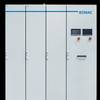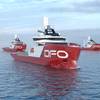Bulkhead Shaft Sealing: IT Really is Rocket Science
Midé Technology Corp., founded in 1989 by MIT PhD. Marthinus van Schoor, is a company created around the design and engineering of smart material based systems and solutions. Historically, the company has not served any specific industry, in fact, it has served many of them, including: work on the international space station; energy harvesting systems on trains; underwater thermally controlled buoyancy systems; and, most recently, work with the U.S. Navy and the commercial marine industry.
In 2004, Midé won a contract from the U.S. Navy to develop a novel bulkhead shaft seal using one of its smart materials, hydrogel embedded foam, a need born out of a situation where a worn out bulkhead seals nearly led to catastrophe.
Typical bulkhead seals are based on a contacting design where a wearing material is always in contact with the spinning shaft, but Midé proposed to the Navy the use of a solution using hydrogel embedded foam for a non-contacting seal designed not to touch the shaft until a flooding event occurred. When the water hits the foam the foam expands and engages a seal with the shaft. The company dubbed these HydroActive seals, and the development ultimately led to Midé Marine.
Midé’s first product for the Navy was a retrofit solution, the Reliant Series RM; a product was designed to integrate with housings already installed on a specific Navy class of ships. When the Navy contracted Midé to develop seals for a new vessel design, it wanted a standalone product sans the heavy housings. To fulfill this need, Midé developed the Reliant YM (yoke model) bulkhead seal, which it has now supplied for two ships classes.
In recent years, the company has developed and introduced a commercial grade seal called the Omni Series, which offers the same non-contacting HydroActive benefits as the Reliant Series for vessles with smaller shaft deflections than typical Navy ships require. This reduced shaft deflection requirement leads to a simpler design and a lower procurement cost.
How it Works
Midé developed a robust and reliable hydrogel embedded foam that provides adequate force and displacement to engage a seal on the shaft. It is important to note that it is scalable to most any size shaft. The process is completely reversible; the foam can be swelled and dried many times over. Heat above a certain threshold actually causes the gel to expel water. While the full process by which the company creates the foam is understandably proprietary, it is worthy to note a number of operational benefits inherent in the design, installation and use of the seals, including:
• Almost zero maintenance costs due to non-contacting nature of the design;
• Safer seal as there is no opportunity for the seal to wear and fail
• Lenient mounting requirements again due to non-contacting/floating nature of the design;
• Unlimited shaft speed during normal operation; still operable during flooding, but speed is limited to 25 m/s surface speed.
• Flexibility: Omni Series (commercial) seals range from 50 to 1000 mm, with a split design to ease installation for refit or newbuild.
Email: [email protected]
www.midemarine.com
(As published in the October 2011 edition of Maritime Reporter + Engineering News - www.marinelink.com)











